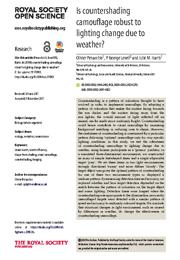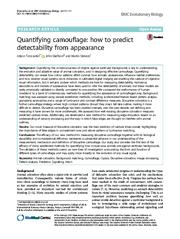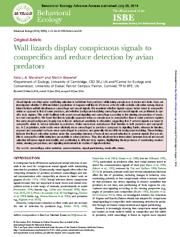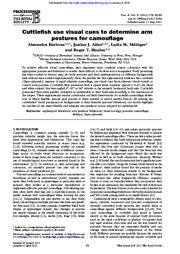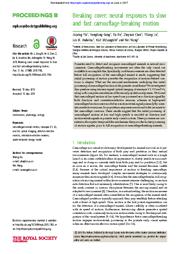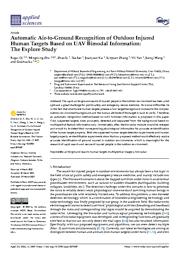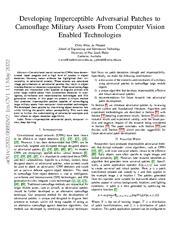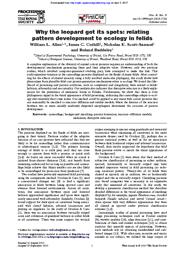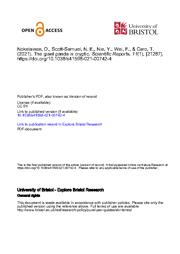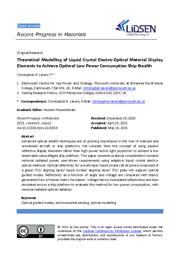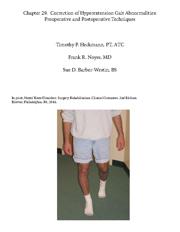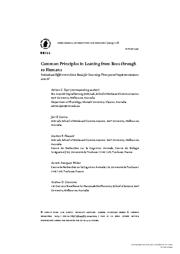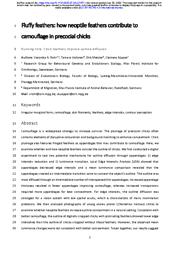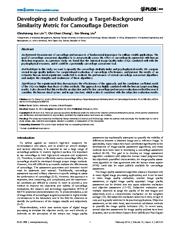A copy of this work was available on the public web and has been preserved in the Wayback Machine. The capture dates from 2019; you can also visit the original URL.
The file type is application/pdf.
Filters
Is countershading camouflage robust to lighting change due to weather?
2018
Royal Society Open Science
Using human observers for testing camouflage in a visual search task offers several advantages. Humans have a complex, evolved visual system that is well studied. ...
From many studies, we know that our visual systems are able to use reliably shading cues as a proxy to 3D shape. ...
doi:10.1098/rsos.170801
pmid:29515822
pmcid:PMC5830711
fatcat:ngwevhzgpjhlrlrjfwyvnnnxr4
Quantifying camouflage: how to predict detectability from appearance
2017
BMC Evolutionary Biology
Numerous descriptions and models of appearance have been used to infer the detectability of animals, but these models are rarely empirically validated or directly compared to one another. ...
We compared the performance of human 'predators' to a bank of contemporary methods for quantifying the appearance of camouflaged prey. ...
Participants consented to their data being used for scientific purposes by clicking the initial start screen. ...
doi:10.1186/s12862-016-0854-2
pmid:28056761
pmcid:PMC5217226
fatcat:hi37pamevnerdm6df5ejlpj33u
Wall lizards display conspicuous signals to conspecifics and reduce detection by avian predators
2014
Behavioral Ecology
Visual signals are often under conflicting selection to be hidden from predators while being conspicuous to mates and rivals. ...
In 2 populations, male backs were relatively more camouflaged to predators compared to signaling flanks, whereas in females, exposed and concealed surfaces were camouflaged to predators and generally did ...
Following this, and prior to visual modeling, human-visible images were aligned with their corresponding UV images in ImageJ 1.45s (64-bit) using a purposewritten script (Troscianko J, unpublished). ...
doi:10.1093/beheco/aru126
pmid:25419083
pmcid:PMC4235580
fatcat:j6s5yivn5vcorgf2t5cornpwkm
Cuttlefish use visual cues to determine arm postures for camouflage
2011
Proceedings of the Royal Society of London. Biological Sciences
Here, we provide the first experimental evidence that cuttlefish (Sepia officinalis), masters of rapid adaptive camouflage, use visual cues from adjacent visual stimuli to control arm postures. ...
To achieve effective visual camouflage, prey organisms must combine cryptic coloration with the appropriate posture and behaviour to render them difficult to be detected or recognized. ...
Using the human visual system as the 'predator', these authors found that the position of moths on trees, i.e. their orientation relative to the background, was important for avoiding detection. ...
doi:10.1098/rspb.2011.0196
pmid:21561967
pmcid:PMC3223637
fatcat:2k5dxuim3be5tdjd4k2hvvokqm
Breaking cover: neural responses to slow and fast camouflage-breaking motion
2015
Proceedings of the Royal Society of London. Biological Sciences
Camouflage-breaking movements are often the only visual cue available to accomplish this. ...
We investigated this question using intrinsic-signal optical imaging of macaque V1, V2 and V4, along with computer simulations of the neural population responses. ...
(d) Model simulation To simulate the neural responses of V1 and V2 populations, we used a spatio-temporal energy model [15, 39, 44] . ...
doi:10.1098/rspb.2015.1182
pmid:26269500
pmcid:PMC4632627
fatcat:p7ui6r6uibhilce7235skkk5je
Automatic Air-to-Ground Recognition of Outdoor Injured Human Targets Based on UAV Bimodal Information: The Explore Study
2022
Applied Sciences
Its crucial difficulties lie in the fact that small-scale human targets possess a low target-background contrast to the complex outdoor environment background and the human attribute of the target is hard ...
to verify. ...
Additionally, human subjectivity and visual fatigu great impact on the results. To facilitate data analysis, it is necessary to preprocess the original multispectral images. ...
doi:10.3390/app12073457
fatcat:buaqm6kmqbaatdo34m5gxsulva
Developing Imperceptible Adversarial Patches to Camouflage Military Assets From Computer Vision Enabled Technologies
[article]
2022
arXiv
pre-print
Traditional camouflage methods are impractical when applied to disguise aircraft and other large mobile assets from autonomous detection in intelligence, surveillance and reconnaissance technologies and ...
These attacks are calculated image perturbations or adversarial patches that result in object misclassification or detection suppression. ...
That is, it is reasonable to foresee a military using conservative benchmarks for true positive detection as a partially correct detection still poses a risk to asset or human life. ...
arXiv:2202.08892v2
fatcat:sr36jl2pgnfndjspzjlmtx3ymq
Why the leopard got its spots: relating pattern development to ecology in felids
2010
Proceedings of the Royal Society of London. Biological Sciences
Furthermore, we show that there is little phylogenetic signal in the visual appearance of felid patterning, indicating that camouflage adapts to ecology over relatively short time scales. ...
Our method could be applied to any taxon with colour patterns that can reasonably be matched to reaction -diffusion and similar models, where the kinetics of the reaction between two or more initially ...
All had normal or corrected-to-normal visual acuity. ...
doi:10.1098/rspb.2010.1734
pmid:20961899
pmcid:PMC3061134
fatcat:w3gbkknhujashlviyi6ayfk2yi
The giant panda is cryptic
2021
Scientific Reports
The results are consistent across acuity-corrected canine, feline, and human vision models. ...
Using photographs of giant pandas taken in the wild and state-of-the-art image analysis, we confirm the counterintuitive hypothesis that their coloration provides camouflage in their natural environment ...
Sandra Winters kindly helped with the cat vision model. We thank Ähtäri Zoo and its staff for helping to take the calibration photos. We thank Ron Swaisgood for introducing FW and YN to TC. ...
doi:10.1038/s41598-021-00742-4
pmid:34711890
pmcid:PMC8553760
fatcat:qzhhl4kndrgi3jblz5ch3tivja
Theoretical Modelling of Liquid Crystal Electro-Optical Material Display Elements to Achieve Optimal Low Power Consumption Ship Stealth
2020
Recent Progress in Materials
We consider here the concept of using passive reflective display elements rather than high power active light projection to achieve a low observable camouflaged ship platform. ...
This paper presents practical consideration towards minimal radiated power user-driven requirements using adaptive liquid crystal electro-optical methods. ...
systems that use image sensors and display panels, to 'cloak' an object 10m long, by 3m high, by 5m wide, weighing less than 45kg. ...
doi:10.21926/rpm.2102019
fatcat:435miztprzfg5jn42zekjwp5ia
Terrain Specific Real Time Pixelated Camouflage Texture Generation & its Impact Assessment
2022
Defence Science Journal
"Camouflage" is a natural or nature identical phenomenon where the sensory route of vision is delayed toavoid visual detection. ...
Photo simulation and saliency maps for hidden object detection have been used to evaluate the effectiveness of generated textures for a given terrain ...
Evaluation of camouflage texture using a saliency map is based on mechanisms of the human visual attention system. This method compares the foreground object to the background scene 37 . ...
doi:10.14429/dsj.72.17599
fatcat:abi4z7imzffjpdrzvjvfn5gklm
Correction of Hyperextension Gait Abnormalities
[chapter]
2017
Noyes' Knee Disorders: Surgery, Rehabilitation, Clinical Outcomes
A visual aid to provide to the patient is the mental image of a woman walking in high heels, which produces 5° to 8° of knee flexion. ...
The clinician must be able to identify the deficiency in order to teach the patient and her or his support system how to observe the deficiency and to perform the corrective strategy. ...
doi:10.1016/b978-0-323-32903-3.00029-9
fatcat:sxfxxqbdczf3xjlv5zdf52da3m
Common Principles in Leaning from Bees through to Humans
2019
Video Journal of Education and Pedagogy
Although bees are separated from humans by about 600 million years with a common ancestor that had only a rudimentary nervous system, they still share over 60% of our Genome. ...
Individual bees show evidence of having different heuristic approaches to solve complex tasks, and maintaining a diversity of cognitive strategies is also probably highly adaptive for group success. ...
Acknowledgements The contents of this article were first presented at the 4th International Association for Visual Pedagogies (AVP) Conference (17- ...
doi:10.1163/23644583-00401014
fatcat:z3anhf5pavdshaxuyxa3xnrd6u
Fluffy feathers: how neoptile feathers contribute to camouflage in precocial chicks
[article]
2020
bioRxiv
pre-print
Camouflage is a widespread strategy to increase survival. The plumage of precocial chicks often contains elements of disruptive colouration and background matching to enhance concealment. ...
Chick plumage also features fringed feathers as appendages that may contribute to camouflage. Here, we examine whether and how neoptile feathers conceal the outline of chicks. ...
human visual system, which are required by the framework. ...
doi:10.1101/2020.07.26.221671
fatcat:emwlprdonbc45kf3cku5asozwa
Developing and Evaluating a Target-Background Similarity Metric for Camouflage Detection
2014
PLoS ONE
It also showed that this method is an objective and effective camouflage performance evaluation method because it considers the human visual system and image structure, which makes it consistent with the ...
We compare several image quality indexes for computational evaluation of camouflage effectiveness, and present the results of an extensive human visual experiment conducted to evaluate the performance ...
UIQI The main function of the human visual system is to extract the structural information of an image, and use this information to form the best approximation of the image perceived quality. ...
doi:10.1371/journal.pone.0087310
pmid:24498310
pmcid:PMC3911984
fatcat:ifohrtesirhvhag74w4skje6aq
« Previous
Showing results 1 — 15 out of 5,216 results

